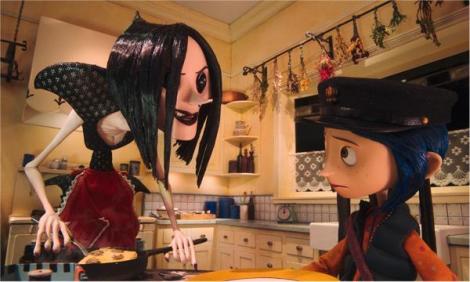Coraline
Film review by: Witney Seibold

“Coraline” was shot in 3-D, but I recommend that you see it without the glasses. Such a gorgeous and imaginative film should be seen with bright clarity, and sans the technically impressive, but ultimately distracting gimmick of 3-D glasses.
“Coraline” is a beautiful, beautiful film. In an animation age of quick-moving, jerky, pop-culture savvy, furry fetish-object, anthropomorphic talking animals, it’s refreshing and glorious to have a dip in the waters of truly frightening, gothic children’s horror. “Coraline” is like and Edward Gorey drawing come to life, replete with all the haunted-mansion oddity and wicked unrelenting grimness therein. No wonder; it was directed by Henry Selick, the man behind “The Nightmare Before Christmas,” based on the twisted poetry of Tim Burton, and “James and the Giant Peach,” based on the book by the pleasingly dour Roald Dahl.
Coraline Jones (Dakota Fanning) has just moved from the big city to a rotting, multi-unit mansion out in the sticks. She is 11 years old, and is displeased with everything. I like that Coraline is not a wide-eyed innocent moppet, but kind of a destructive brat. Y’know, like a lot of 11-year-olds. Coraline’s parents (Teri Hatcher and John Hodgman) are working so hard on their new book, that they haven’t even yet gone grocery shopping. The only times they talk to Coraline is to tell her to calm down and be quiet and to go away. Coraline has little luck befriending the locals, as they are all probably clinically insane. The rambunctious Wybie (Robert Bailey, Jr.) is too nosy, and talks to cats, the Russian acrobat upstairs (Ian McShane) claims to have performing mice, but refuses to show them to anyone, and the two aging trapeze queens downstairs (French and Saunders) have stuffed all their old pets.

Coraline finds escape from this drab world through a mysterious door in her new home. During the day, it is bricked up, but at night, the door opens to a long, umbilical-like tube to an alternate reality version of her house. She discoveres there, that she has an alternat home, that is bright and interesting, and even Other Parents, who pay a lot of attention to her, feed her heaps of rich foods, and care for her every whim. Cats can talk there (the stray she sees in her own world now has the voice of Keith David), and her toys ask to be played with. One thing is a little off-putting for this world, though: all of the inhabitants have buttons for eyes.

No points for guessing that this new plush world is actually more sinister than it first seems, and that Coraline’s Other Mother has bigger plans for her than she first suspects.
Perhaps it’s because Neil Gaiman, the author of the 2002 novel on which this film is based, is British that the film’s scary subject matter is so darkly appealing. In American children’s literature (A Series of Unfortunate Events notwithstanding) most of the child heroes are bland avatars or cutesy shrinking violets who learn to stand up for themselves, save the day, etc. etc. In British children’s literature, there seems to be a stronger connection to the frightening fables of yore, where beasts and ogres would eat up naughty children more often than they would be killed by knights. Hence, we are genuinely scared and awed by the landscapes in “Coraline.” We know that these places are not adventureworlds. They are decaying worlds of constant danger.
Of course, having a love of Gothic horror stories may help you enjoy the film all the more. If you are not already bent towards this type of story, it’s likely you’ll find the people unappealing, and the entire affair entirely unpleasant. Coraline is a brat, the Other Mother is a monster. Even by the end, Coraline has not changed, her parents are still workaholics, and life continues to grind on as drably as ever.
N.B. The story of Coraline strongly resembles the story of a 1992 book called The Thief of Always by Clive Barker. Both feature young children who find a secret house populated by forces and characters that want nothing more than to succor their angst, and overfeed them, but then turn out to be demons or monsters who want to feed off of the children in turn. Did Gaiman steal from Barker? Well, seeing as both tales closely resemble Hansel and Gretel, probably not. I prefer Barker’s wet fleshy terror over Gaiman’s sanitized mythology chop-suey, but that is one for debate.

- Coraline: 1992?
Hm…
Haha!
Yes we totally agree with your comment on Coraline’s similarity to The Thief of Always.
I’m reading the Thief of Always to my daughter right now, and even she keeps comparing the two stories.
If we were to choose – “Thief” gets both our votes 🙂
whats ten similarities and ten differences between The Thief of Always and Coraline?? i love both books but..i like theif better!